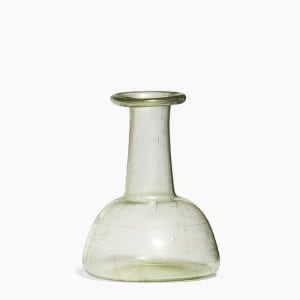Free-blown in clear, colourless glass. The squat body has convex sides with four narrow wheel-cut bands, wide base slightly pushed in, tall cylindrical neck with an everted lip folded over to create a thick rim. An old label inscribed, numbered and dated “B(or 5?).9 Arles/Trainquetaille/Mars 1875” attached to the base. Intact.
Pliny, in his Natural History XXXVI, 198, stated that "the most highly valued glass is colourless and transparent, as closely as possible resembling rock crystal".
Provenance
Louis-Gabriel Bellon (1819-1899), St. Nicholas-les-Arras, France; collection no.B9Bellon was one of the greatest French collectors of the 19th century. Making his fortune in the textile industry, he began to buy and collect archaeological pieces from the Mediterranean world. Until the end of the 1870s, he accompanied Auguste Ternick in archaeological excavations in the Arras region. It was there that he discovered the Gallo-Roman glassworks which subsequently constituted the most important part of his collection. His collection gained notoriety during the retrospective exhibition of French Art which took place at the Trocadéro in 1896, alongside those of Auguste Dutuit and the Protat printers. Today, part of the collection is kept at the Museum of National Antiquities of Saint-Germain-en-Laye, the Petit Palais in Paris, the Louvre Museum, and the Berck-sur-Mer museum.
Literature
Compare Véronique Arveiller-Dulong and Marie-Dominique Nenna, Les Verres Antiques du Musée du Louvre II (Paris, 2005) no.725, p243



